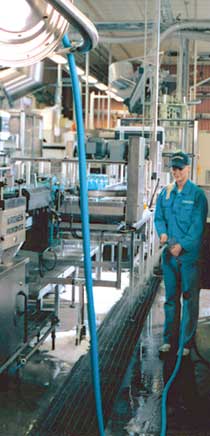Food Safety: Staying ahead of the game

KEEPING YOUR PLANT AND equipment clean is an essential part of any food processor’s sanitary operations, especially when you are making products such as meat and poultry that are known to harbor pathogenic bacteria. In fact, detailed procedures for cleaning and sanitizing are mandatory for these operations and should be included in every operator’s Sanitation Standard Operating Procedures (SSOPs). It is also a good idea for processors of products that are less hazardous to pursue a similar course.
The drill in most food processing operations is to run one or two shifts followed by a clean up. Clean up may last a full shift or it may be less. These processors usually employ a crew that comes in at the end of the last operating shift to start clean up. In the past, the clean up crew often included those with low seniority on the union scale, new employees and people from the local prisons on work furloughs. Too many processors ended up placing food safety in the hands of the least trained employees. Fortunately this practice is not as common as it once was. Today, the importance of clean up and safe operations is acknowledged by good managers. Now clean up crews are given good training, better wages and “a pat on the back.”
Problems still remain with clean up crews or waiting for the end of the work day to clean. That problem is ignoring what goes on during production. There are many line workers who think that because there is a clean up crew or a second shift that will clean up, they are not obligated to do anything. Cleaning up during the work day will not only make the job of the clean up crew easier, but also will keep the plant cleaner and more sanitary during the day. It will also help reduce the microbial load on equipment and may even discourage the first steps of biofilm formation. Teaching your workforce how to do this properly is one of management’s jobs, as is getting them the right tools to do the work.

Workers using squiggies should sweep soil and dirt towards drains or get it in piles so it can be disposed of as food waste. The workers with the hoses have a harder job, however. They must rinse equipment and conveyors without making a greater mess. Management can help them do this work properly by making sure that the crew has the right kind of hoses. All too often, high-pressure hoses are used. This type of hose directs a narrow stream of high-pressure water on a small area. The result is usually a poor washdown and the creation of aerosols.
If you are processing a “sensitive” product that is known to contain listeria or E. coli 0157:H7, these organisms may become part of the aerosol. They will eventually settle back down on the equipment, packing lines or elsewhere. Lower volume hoses allow you to flood and flush the equipment or floors. This will remove the gross soil without creating additional problems.
Looking for a reprint of this article?
From high-res PDFs to custom plaques, order your copy today!








